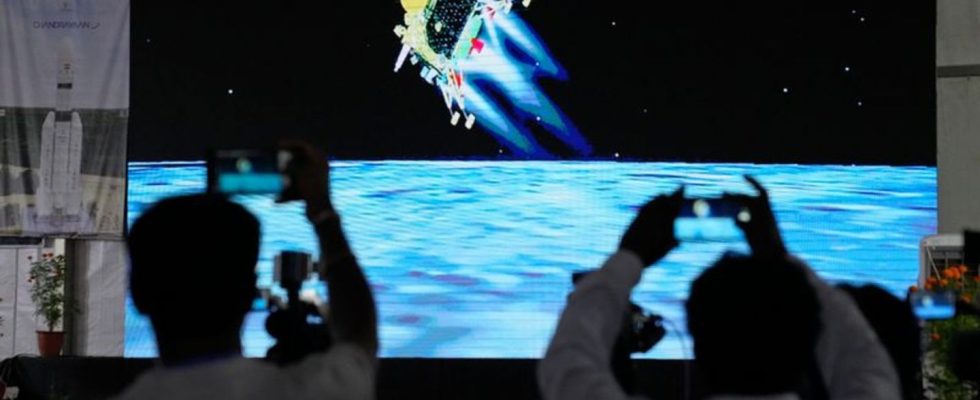space travel
“India is on the moon” – Soft landing succeeded
Cheers erupt during live broadcast of the spacecraft’s landing at the ISRO facility in Bengaluru, India, as “Chandrayaan-3” lands on the moon. photo
© Aijaz Rahi/AP/dpa
Shortly after a Russian spacecraft crash-landed on the moon, India managed a soft landing on the moon. Now the country wants to explore the little-known south side of the moon.
India is the fourth country ever to have a soft landing on the moon done. The Indian space agency ISRO announced that the lunar probe “Chandrayaan-3” touched down on the moon as planned.
“Soft landing on the moon. India is on the moon,” said the head of the Indian space agency ISRO, Sreedhara Panicker Somanath, shortly afterwards. It’s a big leap, said Prime Minister Narendra Modi, who spoke at the BRICS summit in South Africa. Only the Soviet Union, the USA and China had previously successfully landed on the moon.
Destination: South side of the moon
The probe was launched on July 14 from the Satish Dhawan Space Station in the state of Andhra Pradesh. It had first orbited the earth and then switched to a lunar orbit. With the unmanned mission, India wants to explore the south side of the moon, which has hardly been studied, for around two weeks. “Chandrayaan” means “lunar vehicle” in Sanskrit.
A moon landing is not trivial: the moon is littered with debris from failed missions. Most recently, this also happened to the first Russian moon mission in around half a century: the “Luna-25” space probe crashed on the moon on Saturday, the Russian space agency Roskosmos announced in Moscow. “Luna-25” should also have examined a region at the South Pole.
India’s first attempt to land on the moon also failed: four years ago, the landing module on the “Chandrayaan-2” mission, which, like the current one, consisted of an orbiter, a lander and a rover, crashed onto the surface of the moon. Later, the space agency said that there were problems with braking during the approach to the moon. The orbiter is still orbiting the moon today.
According to ISRO, adjustments have been made for the current mission in order to solve the problems of the previous mission. The first probe, Chandrayaan-1, was launched in 2008 and orbited the moon without landing on it.
“Such missions are future-oriented”
With the “Chandrayaan-3” mission, India wants to find out more about frozen water on the moon, which has been detected on and under the lunar surface. Such ice could be useful, among other things, in future manned moon missions.
“Such missions are future-oriented,” said Ajey Lele from the Manohar Parrikar Institute for Defense Studies and Analyzes in the Indian capital New Delhi. “You have to start today if you want to reach your goal in two or three decades.”
India’s space program had started in the 1960s. In the first decades, the focus was primarily on launching satellites into space at low cost. India now has more ambitious goals. Recently, during a visit by India’s Prime Minister Narendra Modi to US President Joe Biden, increased cooperation on space travel was announced.
Orbital exploration began in the 1950s during the Cold War as heated competition between the United States and the former Soviet Union. The Soviets landed an unmanned probe on the lunar surface in 1959. Ten years later, the USA succeeded in the first manned mission with “Apollo 11”. Two years ago, China sent a capsule to the moon and retrieved rock samples. In the course of the “Artemis” project of the USA, people should soon fly to the moon again.
In the meantime, not only state space agencies, but also private companies are trying to land on the moon. Such a privately financed moon landing failed in April: the “Hakuto-R” probe from the Japanese space company Ispace crashed onto the moon in an uncontrolled manner. Previously, other private lunar missions had also failed. Two American companies – Astrobotic and Intuitive Machines – want to try their hand at a private moon landing soon, independently of one another. The motivation is the potentially profitable commercial transport of goods to the moon.

